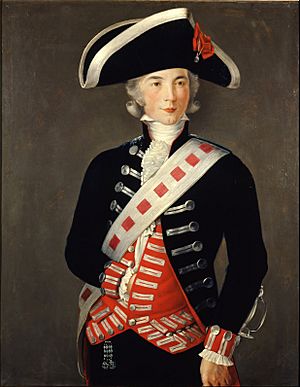Manuel Godoy facts for kids
Quick facts for kids
His Highness
The Most Excellent and Most Serene The Prince of the Peace
|
|
|---|---|
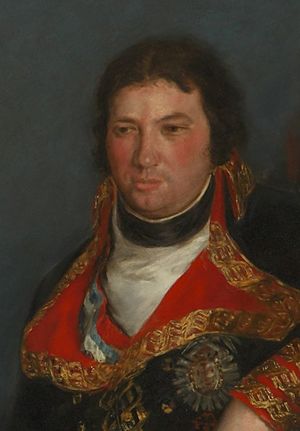
Godoy in 1801, by Francisco de Goya
|
|
| First Secretary of State | |
| In office 15 November 1792 – 28 March 1798 |
|
| Monarch | Charles IV |
| Preceded by | Pedro Pablo Abarca de Bolea |
| Succeeded by | Francisco Saavedra de Sangronis |
| Personal details | |
| Born | 12 May 1767 Badajoz, Spain |
| Died | 4 October 1851 (aged 84) Paris, France |
| Resting place | Père Lachaise Cemetery |
| Spouses |
Josefa de Tudó
(m. 1829) |
| Children |
|
Manuel de Godoy y Álvarez de Faria Rios (born May 12, 1767, in Badajoz, Spain – died October 4, 1851, in Paris, France) was a very powerful Spanish politician. He was known as the First Prince of the Peace. He served as the First Secretary of State (like a prime minister) for the Kingdom of Spain from 1792 to 1797 and again from 1801 to 1808.
Godoy became important at a young age because he was a trusted advisor to King Charles IV and Queen Maria Luisa. He played a big role in Spain during the time of Napoleon and his invasion of Spain. Some people blamed him for the war with Britain (1796-1808), which weakened the Spanish Empire. Godoy's great power ended in 1808 with a public uprising called the Tumult of Aranjuez. This event forced him to live in exile for many years until his death in Paris in 1851.
Contents
Early Life and Family Background
Manuel de Godoy was born in Badajoz, Spain. He was the youngest child in his family. His father was José de Godoy y Cáceres-Ovando, and his mother was Antonia Álvarez de Faria. His family had a long history of nobility, especially from Galicia. They were known for their service to the Spanish Crown.
Godoy had several brothers and sisters:
- José: He became a priest in Badajoz.
- Luis: He was a field-marshal and captain-general. He was also a knight of the Order of Santiago.
- Diego: He became the first Duke of Almodóvar del Campo. He was a knight of the Order of Calatrava.
- María Antonia: She was a noble lady of the Royal Order of Queen María Luisa. She married Miguel de la Grúa Talamanca, 1st Marquis of Branciforte, who was a Viceroy of New Spain.
- Ramona de las Mercedes: She was also a noble lady of the Royal Order of Queen María Luisa.
How Godoy Became a Royal Favorite
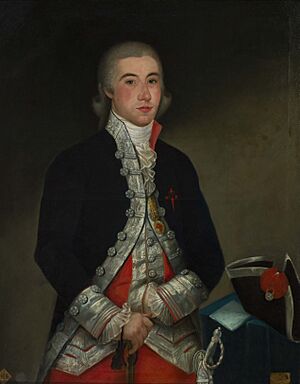

In 1784, when Manuel de Godoy was 17, he moved to Madrid. There, he joined the Guardia de Corps, which were the guards of the Royal Family. He met the future King Charles IV in 1788.
Godoy quickly became a trusted person for King Charles IV and Queen Maria Luisa. He was known for his intelligence and courage. He received many promotions very quickly.
- In 1788, he became a "Cadete supernumerario" in the royal palace.
- By 1789, he was promoted to colonel.
- In 1790, he became a knight of the Order of Santiago.
- By 1791, he was a Field-Marshal and then a Lieutenant-General. He also became a Knight Grand Cross of the Order of Charles III.
These quick promotions showed how much influence Godoy had gained with the King and Queen.
Godoy as Prime Minister of Spain
Godoy's growing influence led him to a very powerful position. In 1792, the previous Prime Minister, Floridablanca, left office. His replacement, Aranda, also left soon after. Queen Maria Luisa then arranged for Godoy to become the Prime Minister. King Charles IV fully accepted this choice. The King was happy to have a capable and trusted person like Godoy to help him govern.
In 1792, Godoy was given the title of Duke of la Alcudia. He also became a Knight of the Order of the Golden Fleece. A year later, he was made Captain General and Duke of Sueca. He also became the Minister for Foreign Affairs of Spain.
Spain at War: Godoy's Role
As Prime Minister, Godoy tried to keep Spain neutral towards the new French Republic. However, things changed when King Louis XVI of France was executed in 1793. Spain protested this and joined an alliance against France. This led to the War of the Pyrenees. French armies advanced into Spanish territory.
Peace Treaty and New Titles
In July 1795, Godoy negotiated the Peace of Basel with France. This treaty restored Spain's borders. However, Spain had to give up its part of the island of Hispaniola to France. Even though some people criticized Godoy for this treaty, he received a special title: "Prince of the Peace" (Príncipe de la Paz).
In August 1796, Godoy signed another treaty with France, the Second Treaty of San Ildefonso. This treaty meant that Spain had to declare war on Great Britain. This put Spain's ally, Portugal, in a difficult spot, as Portugal was allied with Britain.
Personal Life and Honors

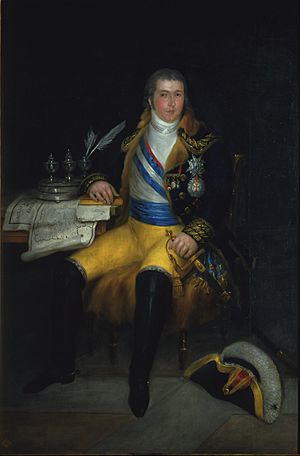
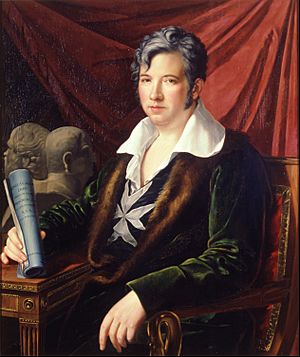
In 1797, Godoy's close friend, Josefa (Pepita) de Tudó, was granted titles like 1st Countess of Castillo Fiel. She was a noble lady of the Royal Order of Queen María Luisa.
Queen Maria Luisa arranged a marriage for Godoy in 1797. She wanted him to marry Doña María Teresa Carolina de Borbón. Maria Teresa was King Charles IV's cousin. This marriage helped restore her family's wealth. They married in September or October 1797. Godoy received money as part of the marriage agreement.
Godoy was removed from the prime minister's office in 1797. He was then made Captain-General (Capitán-General). In October 1800, Godoy's wife, Maria Teresa, had a daughter named Carlota Luisa Manuela. She was baptized with King Charles IV and Queen Maria Luisa as her godparents.
Godoy's Return to Power (1801–1808)
Godoy's cousin, Pedro Cevallos, became prime minister in 1799. This allowed Godoy to take control of Spain's armed forces as generalissimo. With support from France, he declared war on Portugal.
The War of the Oranges
In 1801, Godoy led the Spanish army in an invasion of Portugal. This campaign is known as the War of the Oranges (Guerra de las Naranjas). His army left Badajoz on May 20. Many Portuguese towns surrendered. The Peace of Badajoz was signed on June 6, 1801. Portugal had to give up the town of Olivenza.
In 1802, Godoy negotiated the Treaty of Amiens with Great Britain. Spain gave the island of Trinidad to Britain but got Menorca back.
Increased Power and New Conflicts
In 1804, Godoy was made Generalissimo of the Army of Land and Sea of Spain. This gave him even more power. He was also elected a member of the American Philosophical Society in Philadelphia.
Later in 1804, a British fleet attacked and defeated a Spanish force. This caused Godoy to declare war on Britain again. On October 21, 1805, the French and Spanish fleets were badly defeated at the Battle of Trafalgar. This battle ended Spain's hopes of being a major world naval power.
In 1805, Godoy's close friend, Pepita, had a son named Manuel. In 1807, they had another son, Luis.
The Treaty of Fontainebleau and Godoy's Fall
In 1807, Godoy was given the title of Most Serene Highness. Later that year, he negotiated the Treaty of Fontainebleau with Napoleon. This treaty planned to divide Portugal. Godoy was promised a part of Portugal called the "Principality of the Algarves." This would have secured his future.
However, Napoleon had other plans. He started thinking about making his brother, Joseph Bonaparte, king of Spain. In December 1807, Godoy allowed French troops into Spain. They were supposed to help divide Portugal. But soon, a revolt against the French spread across Spain.
In March 1808, Godoy, King Charles IV, and Queen Maria Luisa tried to escape to New Spain. However, a popular uprising called the Tumult of Aranjuez took place. A crowd stormed Godoy's home. Godoy was found and imprisoned. To stop the uprising and save Godoy's life, King Charles IV gave up his throne to his son, Ferdinand VII.
Supporters of Ferdinand spread stories that Godoy had betrayed Spain to Napoleon. The new king, Ferdinand, was popular. However, Napoleon called King Charles, Queen Maria Luisa, and Ferdinand to a meeting in Bayonne, France. Godoy was rescued from prison and brought to France too. Napoleon demanded that both kings give up the Spanish throne to him. King Charles agreed. After some resistance, Ferdinand also signed over the throne to Napoleon. The Spanish royal family received pensions and guarantees for Spain's territory and religion.
The royal family, including Godoy, then went into exile. King Charles, Queen Maria Luisa, and Godoy went to Italy.
Life in Exile
Godoy spent many years living in exile. He lived with King Charles, Queen Maria Luisa, his daughter Carlota Luisa, his close friend Pepita, and their sons. His wife, Maria Teresa, had divorced him in 1808. They lived in different places in France, like Fontainebleau and Marseille. In 1812, they moved to Rome, Italy.
In 1814, Ferdinand VII became King of Spain again. He refused to let his parents or Godoy return to Spain. He also asked Pope Pius VII to send Godoy and Pepita to Pesaro.
After Napoleon's final defeat, King Charles IV, Queen Maria Luisa, and Pepita returned to Rome. However, the Pope required Godoy to stay in Pesaro. Later, Godoy was allowed to return to Rome. Pepita and her sons moved to Genoa to keep up appearances.
In 1818, Godoy's younger son, Luis, died. Godoy himself became very ill but recovered. At the end of 1818, Queen Maria Luisa became ill and died in January 1819. King Charles IV died only weeks later.
Ferdinand VII continued to prevent Godoy from returning to Spain. He also made sure Godoy did not receive any state pension. Godoy's daughter, Carlota, married Don Camillo Ruspoli in 1821.
In 1828, Maria Teresa, Godoy's former wife, died in Paris. The following year, Godoy married Pepita. Godoy moved to Paris in 1832. He lived there with less money than before, but Louis Philippe, the King of France, later gave him a pension.
In 1836 and 1839, Godoy published his Memoirs. He was allowed to return to Spain in 1844. In 1847, the Spanish government returned some of his property and titles. Manuel de Godoy died in Paris in 1851. He was buried in the Père Lachaise Cemetery.
The famous painting La maja desnuda by Francisco de Goya was once part of Godoy's art collection.
Offices and Titles Held by Godoy
Manuel de Godoy held many important titles and offices in Spain:
- 1st Duque de la Alcudia and Grandee of Spain (1792)
- Prince of the Peace (1795)
- 1st Duke of Sueca and Grandee of Spain (1804)
- 1st Barón de Mascalbó (1806)
- Most Serene Highness (1807)
- Perpetual Regedor (Rector) of many Spanish cities, including Madrid, Valencia, and Sevilla.
- Admiral-Major of Spain and the Indies
- Captain-General of the Royal Armies
- Prime-Minister of King Don Carlos IV
- Knight of the Order of Santiago (1790)
- Knight of the Renowned Order of the Golden Fleece
- Grand Cross of the Order of Charles III
- Bailiff of the Knights of Malta
- 1st Conde de Évora Monte in Portugal (1797)
- 1st Principe di Godoy di Bassano (Italy)
- Grand Sash (Grand Cordon) of the Legion of Honour (France)
Legacy and Impact
Manuel de Godoy is a figure often mentioned in history. Lord Byron, a famous poet, wrote about Godoy in his poem Childe Harold's Pilgrimage. In the poem, a Spanish muleteer blames Godoy for the "ruin of their country." This shows how many Spaniards felt about Godoy during his time. He remains a key figure in understanding Spain's history during the Napoleonic era.
See also
 In Spanish: Manuel Godoy para niños
In Spanish: Manuel Godoy para niños


